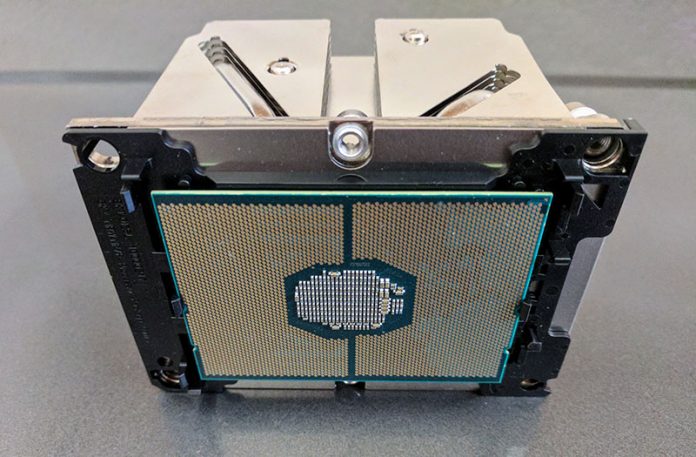It took some time, but we were finally able to secure two Intel Xeon Gold 5119T processors for testing. These are “T” series CPUs which in essence stands for greater Tcase and a lifecycle to service specific markets. Previously, we found that Intel Xeon Scalable T CPUs had no significant performance impact over non-T CPUs. The Intel Xeon Gold 5119T is a different type of CPU since it has no non-T peer in the broader Xeon Scalable ecosystem.
Key stats for the Intel Xeon Gold 5119T: 14 cores / 28 threads, 1.9GHz base and 3.2GHz turbo with 19.25MB L3 cache. The CPU features an 85W TDP. This is a price point Intel has maintained for years. Here is the ARK page with the feature set.
This is a fairly significant chip as it has the most cores that we are aware of in an 85W TDP CPU. It also has a maximum turbo frequency of 3.2GHz, or 0.2GHz above the entire Intel Xeon Silver line.
The Intel Xeon Gold 5100 line supports only up to DDR4-2400 RAM. It does not have the dual port FMA AVX-512 that make the Gold 6100 and Platinum 8100 series parts AVX-512 powerhouses. On the other hand, if you want a lower power server, the 85W TDP is extremely attractive.
Test Configuration
For this CPU review, we are using a 1U Tyan Thunder CX GT75BB7102 test platform.
- CPUs: 2x Intel Xeon Gold 5119T
- System: Tyan Thunder CX GT75BB7102 1U
- RAM: 12x 16GB DDR4-2400 ECC RDIMM (Micron)
- NIC: Mellanox ConnectX-3 EN Pro 40GbE
- OS SSD: Intel DC S3700 400GB
The Tyan Thunder CX GT75BB7102 is a dual socket server that crams a surprising amount of functionality into a 1U chassis. One can put a full complement of 24x DDR4 RDIMMs along with two PCIe x16 cards, multiple OCP mezzanine cards (storage and networking) as well as use M.2 SSDs. The Intel Xeon Gold 5100 series can only utilize up to DDR4-2400 DIMMs so we are not using our DDR4-2666 in this machine.
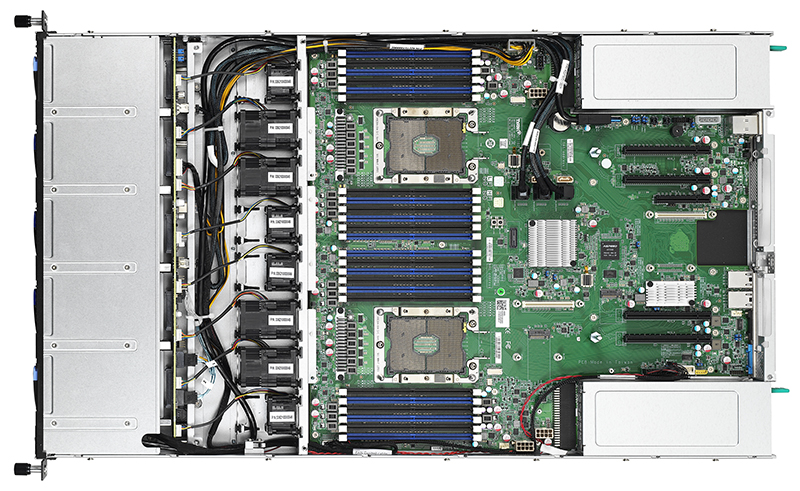
Redundant PSUs flank each side of the motherboard, and Tyan uses a novel array of fans which combine to channel cold air over the parts of the server that need it most.
In terms of storage, along with the PCIe based options, there are 10x storage bays in the front. In our test system, we are using the Intel C621 PCH SATA lanes for a low power setup. One can also use SATA DOMs on the two standard 7-pin SATA connectors.

This configuration also comes with some nice features, for example, the RJ-45 networking ports on the back of the server are 10Gbase-T Ethernet.

Overall, this is a nice platform for low power servers and chips like the Intel Xeon Gold 5100 series.
Dual Intel Xeon 5119T Benchmarks
For this exercise, we are using our legacy Linux-Bench scripts which help us see cross-platform “least common denominator” results we have been using for years as well as several results from our updated Linux-Bench2 scripts. At this point, our benchmarking sessions take days to run and we are generating well over a thousand data points. We are also running workloads for software companies that want to see how their software works on the latest hardware. As a result, this is a small sample of the data we are collecting and can share publicly. Our position is always that we are happy to provide some free data but we also have services to let companies run their own workloads in our lab, such as with our DemoEval service. What we do provide is an extremely controlled environment where we know every step is exactly the same and each run is done in a real-world data center, not a test bench.
We also wanted to note that our dataset is focused on pre-Spectre and Meltdown results at this point. Starting with our Ubuntu 18.04 generation of results we will have comparison points to the new reality. The Spectre and Meltdown patches to hurt Intel’s performance in many tests. At the same time, as of writing this article, patches are still being worked on. Likewise, software is being tuned to deal with the impacts of the patches. Given this, we are going to give the ecosystem some time to settle before publishing new numbers.
Python Linux 4.4.2 Kernel Compile Benchmark
This is one of the most requested benchmarks for STH over the past few years. The task was simple, we have a standard configuration file, the Linux 4.4.2 kernel from kernel.org, and make the standard auto-generated configuration utilizing every thread in the system. We are expressing results in terms of compiles per hour to make the results easier to read.
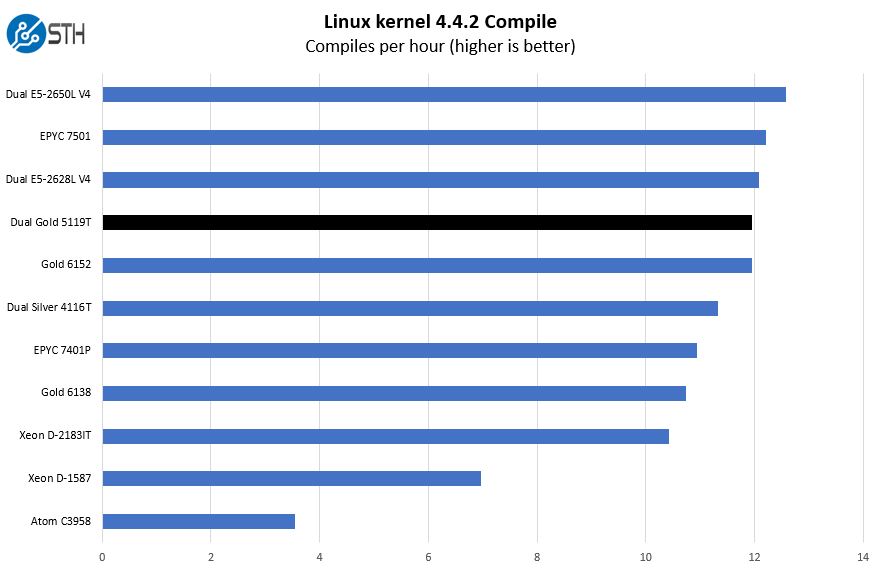
In terms of performance, we see numbers in-line with a single Intel Xeon Gold 6152 which features 22 cores and higher clock speeds. We also see the dual Intel Xeon Gold 5119T in-line with a TDP comparable AMD EPYC 7501 32 core CPU and previous-generation Xeon E5-2628L V4’s.
c-ray 1.1 Performance
We have been using c-ray for our performance testing for years now. It is a ray tracing benchmark that is extremely popular to show differences in processors under multi-threaded workloads. We are going to use both our legacy 4K result along with our new Linux-Bench2 8K render to show differences.
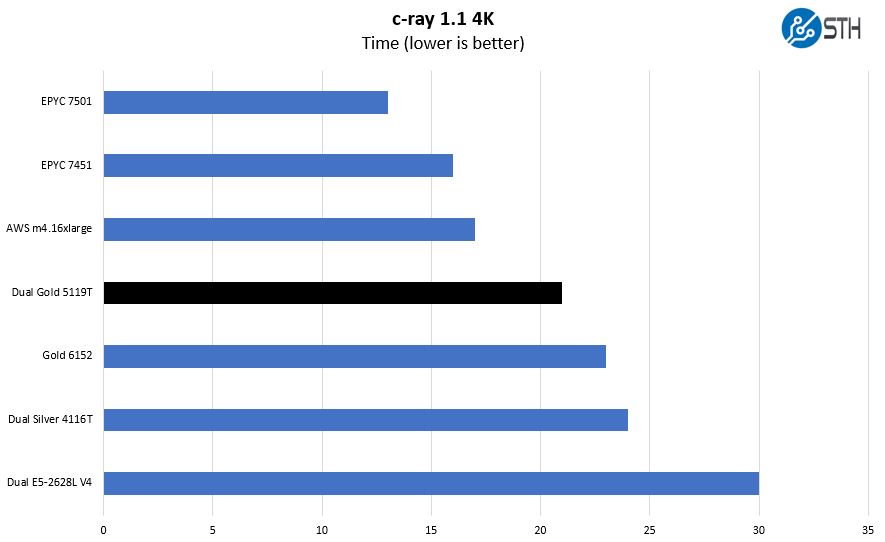
We see a similar pattern in the 8K results:
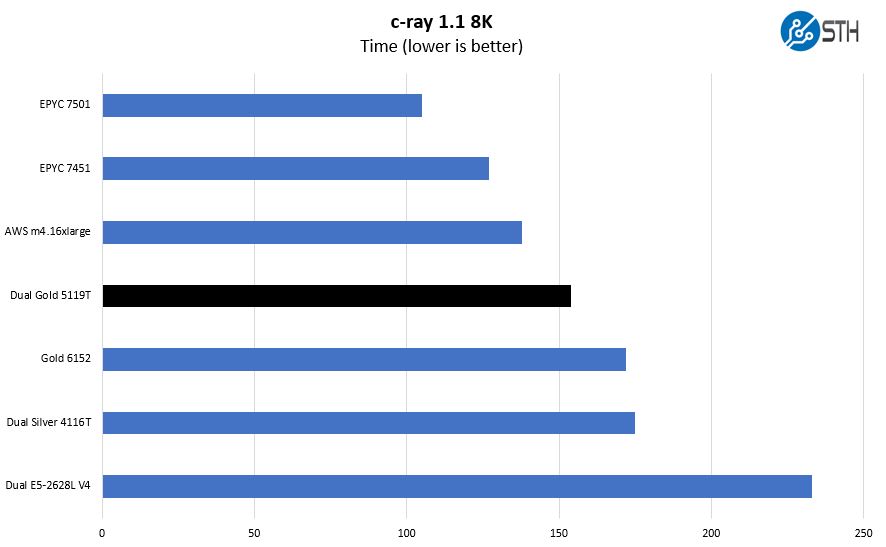
Here we see performance pull ahead of the older Xeon E5 low power parts because of the higher-speed caches.
7-zip Compression Performance
7-zip is a widely used compression/ decompression program that works cross-platform. We started using the program during our early days with Windows testing. It is now part of Linux-Bench.
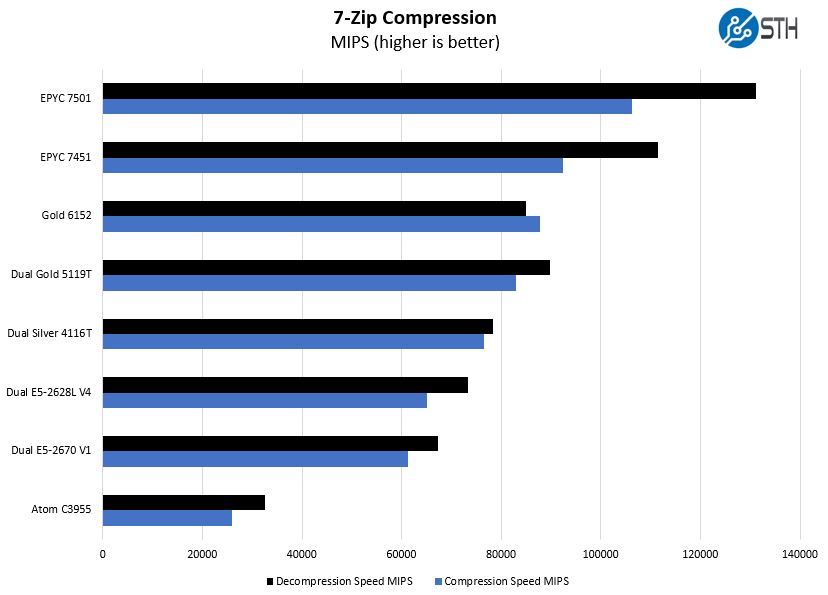
There is a modest improvement over the Intel Xeon Silver 4116T despite the two solutions holding the same TDP spec. These chips are also significantly faster than 115W TDP Xeon E5-2670 V1 chip that had much higher clocks.
NAMD Performance
NAMD is a molecular modeling benchmark developed by the Theoretical and Computational Biophysics Group in the Beckman Institute for Advanced Science and Technology at the University of Illinois at Urbana-Champaign. More information on the benchmark can be found here. We are going to augment this with GROMACS in the next-generation Linux-Bench in the near future. With GROMACS we have been working hard to support Intel’s Skylake AVX-512 and AVX2 supporting AMD Zen architecture. Here are the comparison results for the legacy data set:
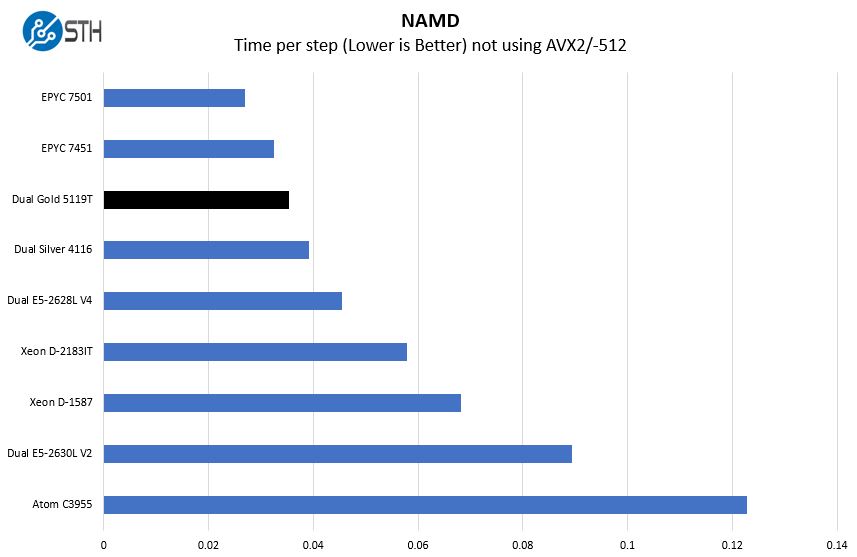
This benchmark favors the AMD architecture, but we can again see gains over the Xeon Silver 4116 and the previous generation Xeons.
Sysbench CPU test
Sysbench is another one of those widely used Linux benchmarks. We specifically are using the CPU test, not the OLTP test that we use for some storage testing.
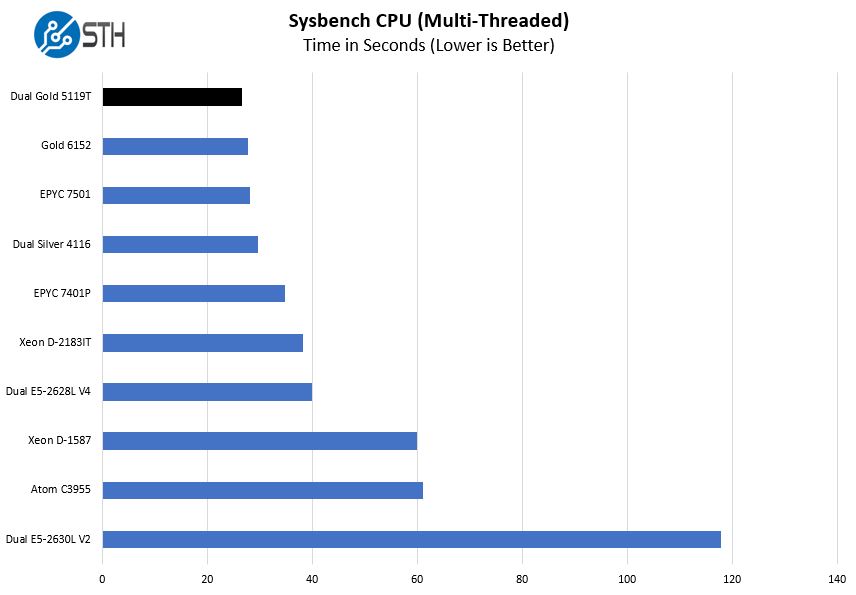
Here the performance tops our chart.
OpenSSL Performance
OpenSSL is widely used to secure communications between servers. This is an important protocol in many server stacks. We first look at our sign tests:
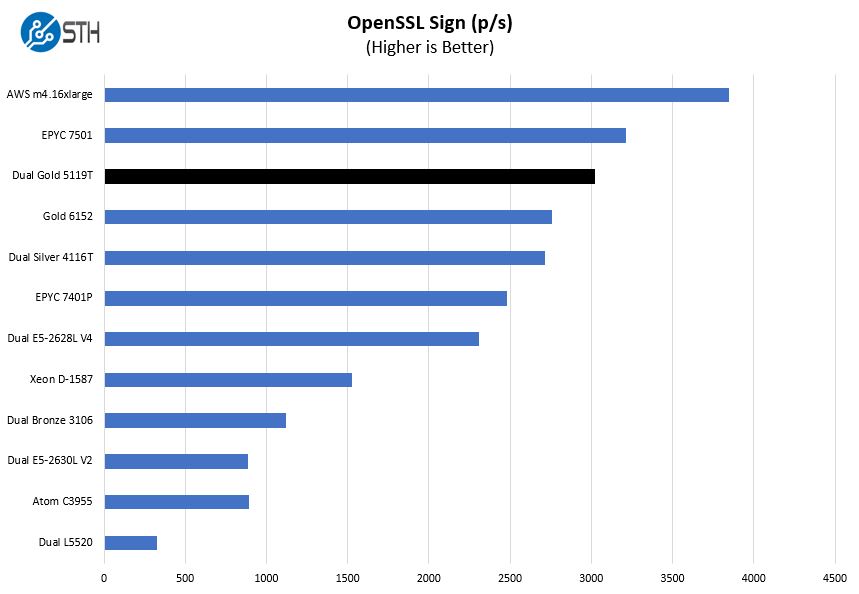
And the verify results:
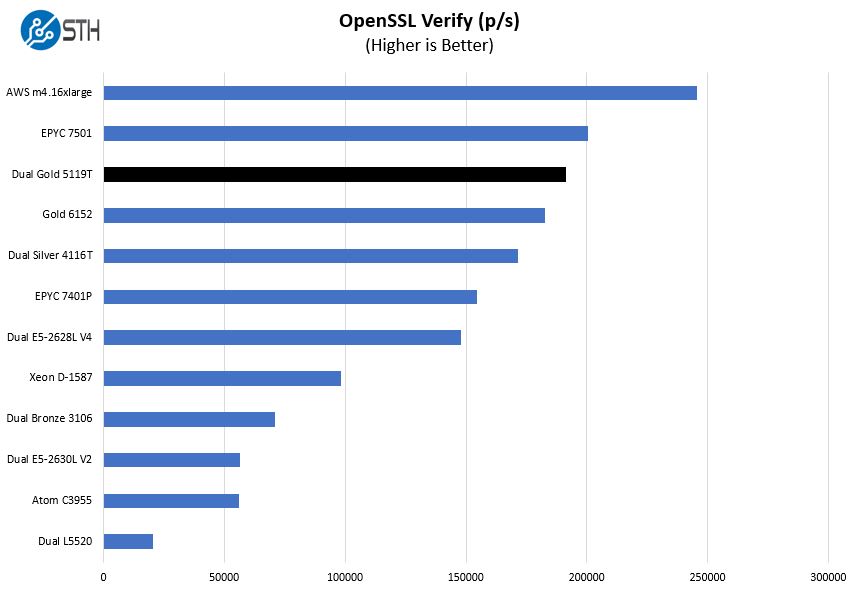
We added higher-end cloud instance numbers to this chart to show how well these solutions stack up. As you can see, having many low power cores is a benefit to Intel.
UnixBench Dhrystone 2 and Whetstone Benchmarks
Some of the longest-running tests at STH are the venerable UnixBench 5.1.3 Dhrystone 2 and Whetstone results. They are certainly aging, however, we constantly get requests for them, and many angry notes when we leave them out. UnixBench is widely used so we are including it in this data set. Here are the Dhrystone 2 results:
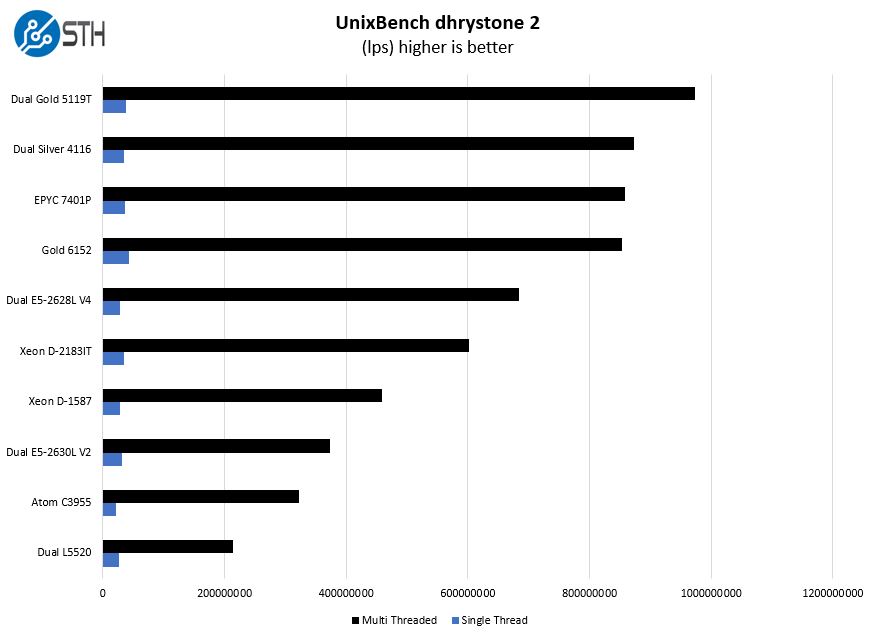
And the whetstone results:
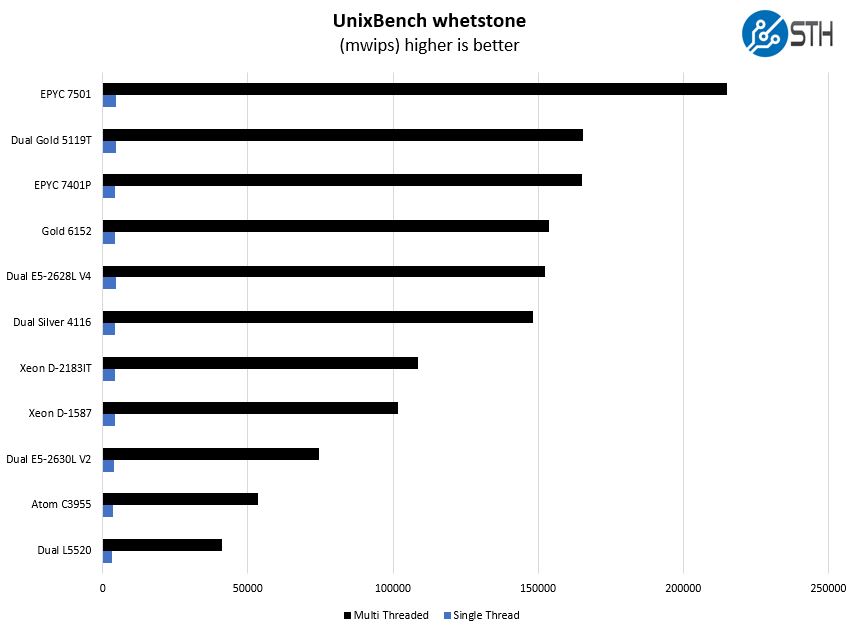
Although the blue single thread bars are small, there is a solid performance gain in single thread performance in our dual Intel Xeon Gold 5119T setup over the dual Silver 4116T.
GROMACS STH Small AVX2/ AVX-512 Enabled
We have a small GROMACS molecule simulation we previewed in the first AMD EPYC 7601 Linux benchmarks piece. In Linux-Bench2 we are using a “small” test for single and dual socket capable machines. Our medium test is more appropriate for higher-end dual and quad socket machines. Our GROMACS test will use the AVX-512 and AVX2 extensions if available.
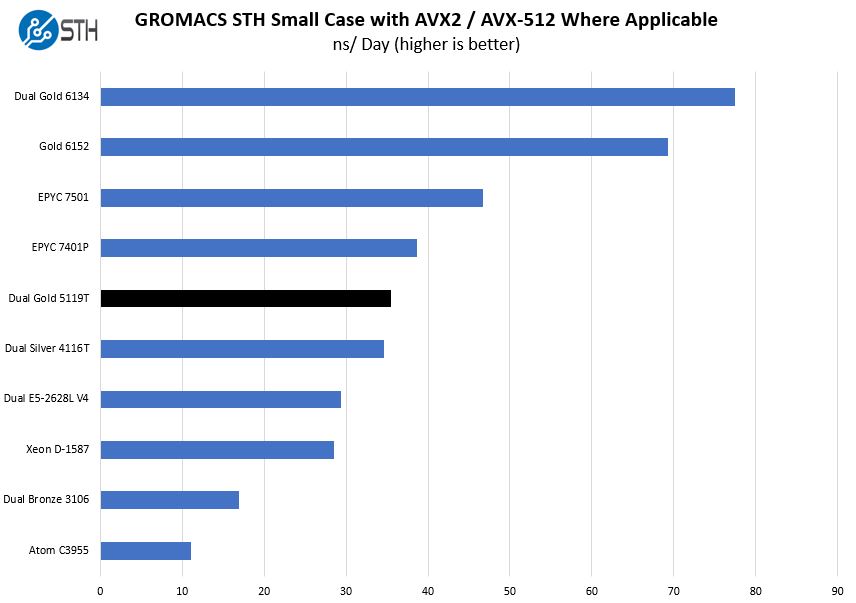
Here the performance of the Intel Xeon Gold 6100 series really shines as a single 22 core Intel Xeon Gold 6152 outpaces the dual Intel Xeon Gold 5119T setup with 28 cores, by a larger margin. This is because the Intel Xeon Gold 5100 series does not have dual port FMA AVX-512 units.
Chess Benchmarking
Chess is an interesting use case since it has almost unlimited complexity. Over the years, we have received a number of requests to bring back chess benchmarking. We have been profiling systems and are ready to start sharing results:
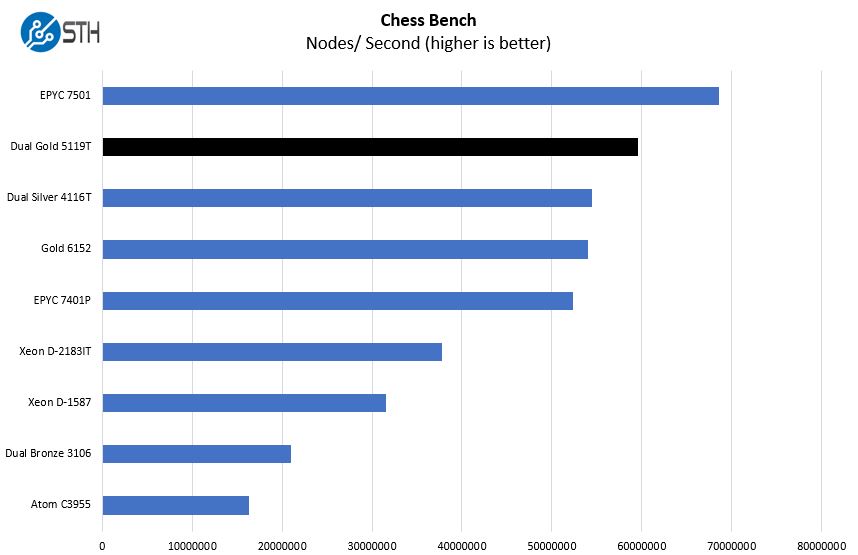
Overall we can see extremely solid figures in the chess benchmark with clear victories over the dual Intel Xeon Silver 4116.
A Note on Power Consumption
We wanted to post a few figures from our testing that show the real selling point of the chips, low power.
- Idle: 70W
- 70% Load: 179W
- 100% Load: 211W
- Peak: 219W
Note these results were taken using a 208V Schneider Electric / APC PDU at 17.8C and 72% RH. Our testing window shown here had a +/- 0.3C and +/- 2% RH variance. These are great power consumption figures. These are certainly solid results for this system and a large amount of the power is not used by the CPU and instead by the RAM and peripherals.
Market Positioning
Thes chips are not released in a vacuum instead, they have competition on both the Intel and AMD sides. When you purchase a server and select a CPU, it is important to see value of a platform versus its competitors.
2P Intel Xeon Gold 5119T v. Intel Xeon
In the world of Intel Xeon the Xeon Gold 5119T is a very interesting SKU. It is only available in the “T” series but has a number of attributes that sets it apart.
The Intel Xeon Silver 4116 is realistically the SKU buyers would consider at 85W TDP. The Silver 4116(T) sits below the Intel Xeon Gold 5119T in terms of features and performance. The Silver 4116T has 12 cores / 24 threads versus 14C/ 28T and that comes with less cache. Another feature of the Gold 5119T is the ability to turbo boost clock speeds to over 3.0GHz.
Above the Intel Xeon Gold 5119T essentially means adding TDP along with cores. The likely reason that Intel did not include a non-T part at the 5119 level is that buyers of that many cores often will want higher clocks and can handle an associated rise in TDP.
2P Intel Xeon Gold 5119T v. AMD EPYC
On the AMD EPYC side, things get intriguing. AMD EPYC has a single socket focused SKU, the AMD EPYC 7551P that has 32 cores / 64 threads and a 180W TDP. The max turbo frequency on that SKU is 3.0GHz, slightly lower than the Gold 5119T, but the base clock is 2.0GHz or slightly higher. If the extra 10W TDP, and trading up to more cores in a single socket works for an application, AMD is simply about $900 or 30% less expensive than dual Intel Gold 5119T CPUs, and certainly performance competitive.
At the same time, AMD does not have anything competitive from a TDP perspective.
Final Words
If you want to stretch the limits of what low power Intel Xeon Gold series CPUs can do, then the Intel Xeon Gold 5119T is the part to look at. It combines low power consumption with relatively high core counts and solid performance. If you are in a per-core, per-socket, or per server software licensing scenario, it may make sense to move up the SKU stack to higher-end offerings that get full DDR4-2666 memory speeds and the full dual port FMA AVX-512 implementation.

